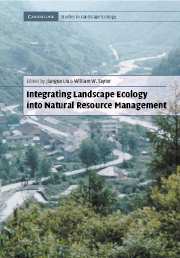Book contents
- Frontmatter
- Contents
- List of contributors
- Foreword
- Preface
- Acknowledgments
- PART I Introduction and concepts
- PART II Landscape structure and multi-scale management
- PART III Landscape function and cross-boundary management
- PART IV Landscape change and adaptive management
- PART V Landscape integrity and integrated management
- PART VI Syntheses and perspectives
- Index
- Plate Section
PART IV - Landscape change and adaptive management
Published online by Cambridge University Press: 14 January 2010
- Frontmatter
- Contents
- List of contributors
- Foreword
- Preface
- Acknowledgments
- PART I Introduction and concepts
- PART II Landscape structure and multi-scale management
- PART III Landscape function and cross-boundary management
- PART IV Landscape change and adaptive management
- PART V Landscape integrity and integrated management
- PART VI Syntheses and perspectives
- Index
- Plate Section
Summary
Landscapes change constantly due to both natural and anthropogenic disturbances (including management practices). The varying nature of landscape structure and function increases the complexity of landscape research and management. Because landscapes are often not in an equilibrium state and there are various degrees of uncertainty, it is necessary to monitor and predict their temporal dynamics as well as their ecological consequences. Furthermore, management strategies need to be modified accordingly, because management practices suitable for previous landscape conditions may not be appropriate for new circumstances. To ensure the success of new management strategies, their potential short- and long-term consequences must be evaluated before implementation. One paradigm that encompasses these ideas is adaptive management, which is becoming increasingly popular in natural resource management but is rarely considered in the context of landscape change. Authors of the four chapters in Part IV present useful tools and approaches that link landscape change research and adaptive management.
Land use is a major driving force of landscape changes. To quantify spatial patterns of land-use changes and their impacts on land cover and species over time, Dale et al. (Chapter 10) developed a modified landscape-transition matrix model. This model was then applied to the Fort McCoy military base in Wisconsin to simulate the impacts of military land uses on the habitat of the endangered Karner blue butterfly. The risk maps generated from the model identify specific locations where different management actions are needed. Thus, the model provides a useful tool for land managers using an adaptive management framework.
Improving efficiency of sampling across landscapes is particularly important in monitoring landscape changes.
- Type
- Chapter
- Information
- Integrating Landscape Ecology into Natural Resource Management , pp. 263 - 264Publisher: Cambridge University PressPrint publication year: 2002
- 1
- Cited by



